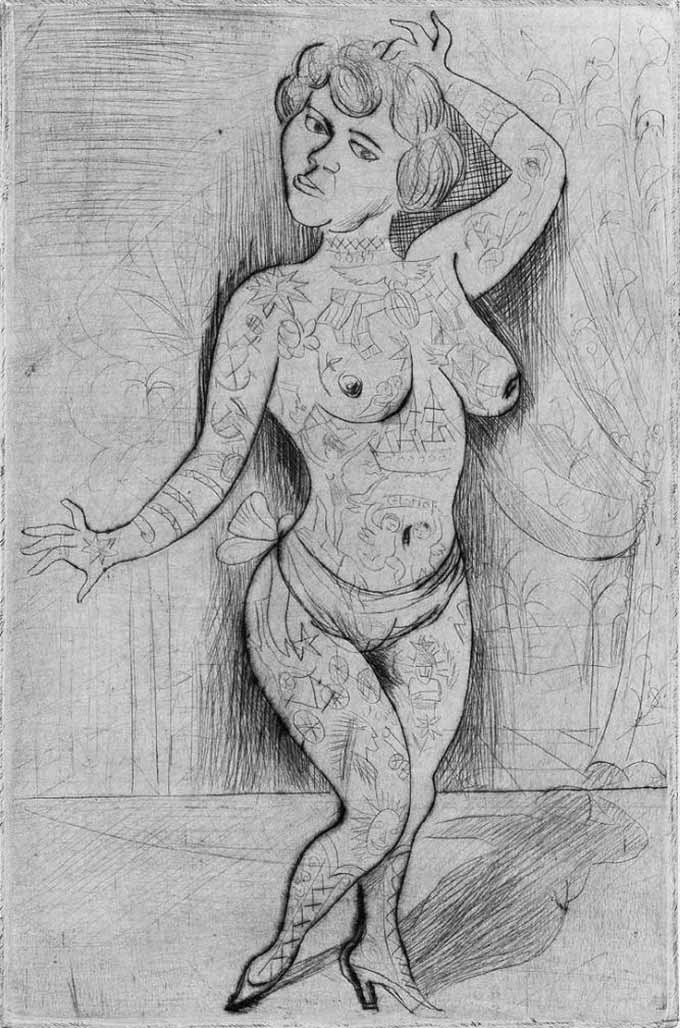Naked Truth: Approaches to the Body in Early-Twentieth-Century German and Austrian Art
–
Co-curated by professors Eliza Garrison (History of Art and Architecture), Bettina Matthias (German) and the students in their spring 2015 course “The Body in German and Austrian Art,” this show explores depictions of the body that revolutionized the millennia-old tradition of the nude in Western art and remain just as controversial and thought-provoking today as they were a century ago.
In 1899 Gustav Klimt’s painting Nuda Veritas shook up the Austrian public with what many deem the painter’s most political exploration of the nude female body. Klimt’s provocative allegory challenged viewers to consider their own beliefs about the relationship between the nude (female) body and contemporary morality; this “naked truth” was shocking. Transcending accusations of “pornography,” Klimt’s work paved the way for artistic explorations of the nude body as the site through which questions of freedom, desire, beauty, nature, culture, power, and their antonyms could be represented and negotiated.

Otto Dix (German, 1891–1969), Maud Arizona (Suleika, das tätowierte Wunder) [Suleika, The Tattooed Wonder], 1922, etching, 19 5/8 x 16 7/8 inches. Sabarsky Collection.
Featuring works on paper by fifteen artists including Klimt, Max Beckmann, Otto Dix, George Grosz, Ernst Ludwig Kirchner, Käthe Kollwitz, and Egon Schiele, the exhibition explores the conceptions of the human body and the manner of its visualization in the period leading up to and following the First World War, which changed the world’s notions of flesh and blood forever.
In the early 20th century, rapid developments in technology led to a faster pace of life, and the disorienting experience of Modernism became a central motif for the art of this period. In particular, the First World War was a key moment for the artists in this exhibition, many of whom either fought on the front lines as soldiers or lost loved ones in the conflict. As a result, the traditional approach to the nude as an idealized representation of heroes and deities gave way to depictions of imperfect, disturbed bodies—bodies that are old, worn-out, mutilated, or abstracted.
For example, war veteran Otto Dix’s Sterbender Soldat (Dying Soldier) depicts the grotesque, decaying body of a soldier, while Hunger by Käthe Kollwitz, whose youngest son died on the battlefield, depicts an emaciated mother mourning over the dead child on her lap. Willi Baumeister’s Sitzende Figur (Sitting Figure)/em> presents an alternate vision of the body, rendering the human form in a highly abstracted, mechanized manner, alluding to industrialization and the convergence of human and machine.
Naked Truth is the second installment in a series of three exhibitions organized in collaboration with the Serge Sabarsky Foundation. As a part of this three-year initiative, the Foundation has made works from its large collection of German and Austrian art available to Middlebury students and faculty so that a class taught in the spring semester would have a chance to work directly with the art and to have a voice in the curation of an exhibition to open the following fall.
For this exhibition, students made innovative use of digital media to create “Dress the Nude” projects, which explore the relationship between clothed and naked bodies, in addition to a series of digital tours, which provide visitors with the opportunity to learn about various themes that run throughout the exhibition. The projects will be installed on iPads for all visitors to enjoy.
Naked Truth will be followed by the third and final Sabarsky exhibit, Bloom and Doom: Visual Expressions and Reform in Vienna 1900, which will open in the fall of 2016.
